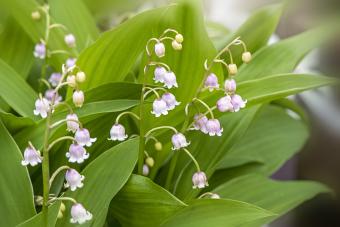
Lily-of-the-Valley (Convallaria majalis) is a beautiful, fragrant plant that has green leaves and produces multiple white or pink, bell-shaped pendant flowers on stalks that grow between the leaves. This plant, which is also called Mary's tears or Mary's bells, provides a lush green blooming groundcover, but there are some cautions to consider before planting it. Lily-of-the-valley is very pretty, but it spreads so rapidly that it is considered to be invasive. It's also toxic to both humans and animals.
Growing Lily-of-the-Valley in Your Landscape

If you are still interested in planting lily-of-the-valley now that you know it is both invasive and toxic, you'll be glad to learn that this plant is not difficult to grow. Lily-of-the-valley is hardy in USDA planting Zones 2-9 and grows to stand between six and 12 inches tall. People who grow this plant often use it as groundcover for steeply sloping land or in a woodland garden. You won't want to put it in garden beds or other planting areas, though, as it will crowd out and overtake any plants in its path.
Where to Plant Lily-of-the-Valley: Light and Soil Requirements
Lily-of-the-valley will grow in just about any type of soil or light conditions. It prefers to grow in moist soil that drains well with light shade. It will grow and even bloom in full shade, but it will produce fewer flowers than if it has more light. It will also grow in full sun.
Watering and Fertilizing Lily-of-the-Valley
Lily-of-the-valley does not need any fertilizer, which is usually the case with invasive plants. They do need water because their roots like to stay moist (but not waterlogged). Their roots should be most when they are planted, and they should be watered frequently while they are getting established. As long as they remain in moist, well-draining soil, they'll continue to thrive.
- Before you plant potted lily-of-the-valley plants in their final home, be sure they are well-watered.
- If you're planting bare root transplants, soak the plant's rhizomes (roots) in water for approximately an hour before you plant them.
- Water your lily-of-the-valley plants at least once per week for the first month (or even a few weeks longer) after they are transplanted.
- Established lily-of-the-valley plants planted in partial or full shade generally only need to be watered when conditions are so hot and dry that their roots dry out.
If their roots dry out or become waterlogged for an extended period of time, that can kill these plants.
Pruning Lily-of-the-Valley
Lily-of-the-valley does not require pruning. If you want to snip off some blooms to use in floral arrangements, you can definitely do that. Otherwise, you can just leave these plants alone. You don't even need to deadhead spent blooms. Depending on how warm your climate is, the plant may stay green all year. If you're in a colder area where these plants don't green all year, there is still no need to prune them. They'll transition into winter mode on their own, then bounce back in the spring.
Lily-of-the-Valley Pests and Diseases
These plants have one pest and a few disease concerns. Pest-wise, black vine beetles are a concern for lily-of-the-valley plants. They don't kill the plants, but they do cause cosmetic damage by chewing notches into the edges of the leaves. If you want to try to get rid of the weevils, treat the plant's leaves with neem oil or another type of herbal insect repellent. Lily-of-the-valley plants are prone to develop a few fungal diseases. For example:
- Anthracnose - If your plants develop dark lesions on the leaves, this is a sign that they may have anthracnose, which is a type of leaf spot. It isn't deadly, but it can reduce flower production. Remove affected leaves and treat the plant with a fungicide.
- Rust - If you see yellow spots on the top of the leaves and orange spots on the bottom, that means your plants have rust. This doesn't usually kill the plant, so you can just snip off discolored leaves and treat the plant with a fungicide.
- Crown rot - Unlike anthracnose and rust, crown rot will destroy lily-of-the-valley plants. This fungus starts at the top (crown of the plant) and spreads downward, leaving discolored leaves in its path. It will kill affected plants within a few days.
- Stem rot - Following the opposite path of crown rot, stem rot starts at the base of the plant and spreads upward. It is deadly to these plants. The leaves of affected plants will turn yellow and develop spots as the rot spreads, then the plant will die.
Propagating Lily-of-the-Valley
Lily-of-the-valley propagates very easily. It spreads aggressively on its own, so no effort is required to propagate it. However, if you are looking to get plants to share or to put in another area of your landscape, it's easy to divide them. Just dig some when the plant is dormant in fall and separate their rhizomes, then pot them or replant in another in-ground location. They'll start spreading as soon as they get established. Leave several inches (at least four) between plants; they'll spread to fill in the gaps very quickly.
Interesting Lily-of-the-Valley Varieties

Most lilies-of-the-valley have green leaves and white flowers. Some varieties have pink flowers, some have two-tone flowers, and some have variegated leaves. If you want to add lily-of-the-valley to your landscape but are looking for something more unusual than basic white flowers with solid green leaves, try one of the cultivars listed below.
Flore Pleno
If you're looking for maximum blooms, (Convallaria majalis ' Flore Pleno') is an interesting option due to the fact that it has double blooms. It is sometimes referred to as a double lily-of-the-valley.
Aureovariegata
Aureovariegata (Convallaria majalis 'Albostriata') produces single white flowers but is distinct in appearance due to the striping on its leaves. Its green leaves are marked with yellow stripes.
Albostriata
Albostriata (Convallaria majalis 'Albostriata') has uncommon flowers and leaves. This variety produces cream and white flowers, and its green leaves are highlighted with cream stripes.
Rosea
Pink lily-of-the-valley flowers are less common than white ones, but they do exist. The rosea (Convallaria Majalis var. rosea) variety has lovely light pink flowers.
Good Companions for Lily-of-the-Valley
Since this plant spreads quickly and is invasive, it doesn't have much in the way of flower companions. It will overtake pretty much anything fairly small that is in its path. Lily-of-the-valley can be an appropriate ground cover under evergreen or deciduous trees or as a border in front of large shrubs. No matter where you plant lilies-of-the-valley, you're going to have to work to keep them from encroaching into your landscape beyond the area where you want them to be.
Plant With Caution
Lilies-of-the-valley are beautiful, especially when they are blooming in the early spring. However, it's important to consider the fact that they are toxic and invasive plants before introducing them into your landscape. They're low-maintenance plants to keep alive, but high maintenance when it comes to keeping their spread in check. You might want to consider just keeping a few of these plants in a container if you really want to have some. There are plenty of other garden groundcovers that are neither toxic nor invasive.







